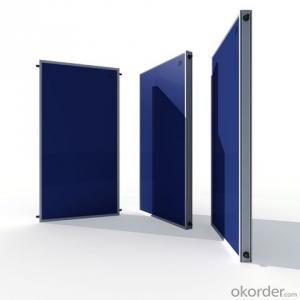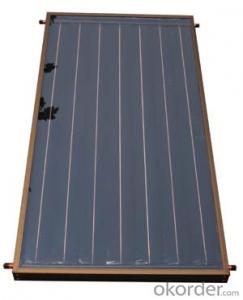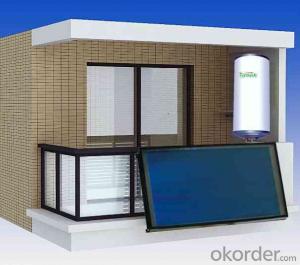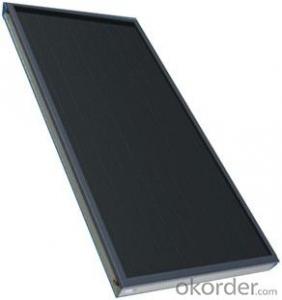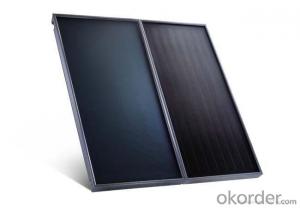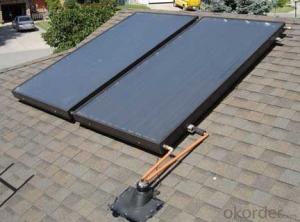Pressurized Heat Pipe Solar Water Heater System
- Loading Port:
- China main port
- Payment Terms:
- TT OR LC
- Min Order Qty:
- 1 set
- Supply Capability:
- 6000 set/month
OKorder Service Pledge
OKorder Financial Service
You Might Also Like
Introduction of Non-Pressure Solar Water Heater:
Non-pressure Solar Heater is one of the most economical solar water heating device with pretty high efficiency at the same time. It consists of hot water storage tank, solar vacuum tubes with mouth plug in storage tank, and bracket supporting tank and tubes.When cold water in evacuated tubes is heated with solar irradiation, as the specific gravities of hot water and cold water are different, hotter water goes upward to storage tank and colder water goes downward to glass tubes. through this continuous circulation, the cold water in storage tank will be gradually heated till sunset.
Specialty:
1. High thermal performance and working temperature: the heat exchanging rate even in winter can up above 55%.
2. Heat collecting efficiency is at least 20% above common solar systems.
3. Work in all day and all season: no matter any corner of the world, this system can work well even -40℃ to avoid the tube freezing problem.
4. Reliability: No water following through the tube, so water scale can not generate and tube cracks could be avoided, the system still can keep working even with some damaged tubes.
5. It can connect with water tap and work automatically with pressure0.6Mpa, bring enjoyable washing experience.
6. Safety: P/T valve would release pressure and temperature to protect tank..
Technical Specification:
1. Outer tank material: SUS304 stainless steel or powder coated color steel
2. Inner tank material: 1.2mm thick SUS304 food grade stainless steel ( Optional material SUS316L)
3. Vacuum tube material: borosilicate glass 3.3; AL-SS-CU absorb coating, with copper heat pipe inside
4. Frame material: 1.2mm thickness stainless steel
5. Insulation material: 55mm thickness polyurethane
6. Suitable for mains pressure water(up to 8 bar/116psi)
7. Easy plug-in installation
8. Install the T/P valve on the pressurized tank
9. Seal material: Stabilized High Temperature Silicon
Outer tank material: SUS304 stainless steel or powder coated color steel
Inner tank material: 1.2mm thick SUS304 food grade stainless steel ( Optional material SUS316L)
Vacuum tube material: borosilicate glass 3.3; AL-SS-CU absorb coating, with copper heat pipe inside
Frame material: 1.2mm thickness stainless steel
Insulation material: 55mm thickness polyurethane
Suitable for mains pressure water(up to 8 bar/116psi)
Easy plug-in installation
Install the T/P valve on the pressurized tank
Seal material: Stabilized High Temperature Silicon
19. Vacuum Tube | 20. Size (mm) | 21. Φ47*1500 / Φ58*1800 / Φ70*2100 | |||||
22. Tube (pcs) | 23. 10 / 12 / 15 / 18 / 20 / 22 / 24 / 30 / 36 / 42 | ||||||
24. Material | 25. Borosilicate 3.3 glass, magnetron spluttering selective coating | ||||||
26. Coating | 27. Single-target AL-N/AL or Three-target AL/N-Cu-SS | ||||||
28. Water Tank | 29. Capacity | 30. 80L ~ 500L for hot water storage tank | |||||
31. Inner tank | 32. Food-grade stainless steel SUS304-2B / SUS316 | ||||||
33. Insulation | 34. High-density polyurethane foam with 70~80 hour heat preservation | ||||||
35. Tank shell | 36. Food-grade stainless steel SUS304-2B | ||||||
37. Bracket | 38. Shaped strong aluminum alloy structure adaptable for flat or slope roof | ||||||
39. Accessories | 40. Anti-aging silicon seals, Dustproof seals, Air-vent cap, Stainless screws | ||||||
41. Auxiliary Devices | 42. Assistant tank, Intelligent controller, Electrical heater, Magnesium anodes | ||||||
43. Tilt Angle | 44. 25 ~ 50° | ||||||
45. Water Output | 46. 45 - 95°C | ||||||
47. Hail Resistance | 48. Φ25mm diameter | ||||||
49. Model Number | 50. Solar Vacuum Tube | 51. Tank 52. Liter | 53. System 54. Liter | 55. Container Loading Qty /sets | |||
56. Size /mm | 57. Qty /pcs | 58. 20GP | 59. 40GP | 60. 40HQ | |||
61. VNS-58SA12-100 | 62. Φ58*1800 | 63. 12 | 64. 100 | 65. 132 | 66. 58 | 67. 119 | 68. 140 |
69. VNS-58SA15-130 | 70. 15 | 71. 130 | 72. 170 | 73. 54 | 74. 108 | 75. 131 | |
76. VNS-58SA18-150 | 77. 18 | 78. 150 | 79. 198 | 80. 43 | 81. 86 | 82. 105 | |
83. VNS-58SA20-170 | 84. 20 | 85. 170 | 86. 223 | 87. 40 | 88. 80 | 89. 97 | |
VNS-58SA24-200 | 24 | 200 | 263 | 35 | 70 | 85 | |
VNS-58SA30-250 | 30 | 250 | 329 | 28 | 56 | 68 | |
VNS-58SA36-300 | 36 | 300 | 395 | 23 | 47 | 57 | |
Product Show
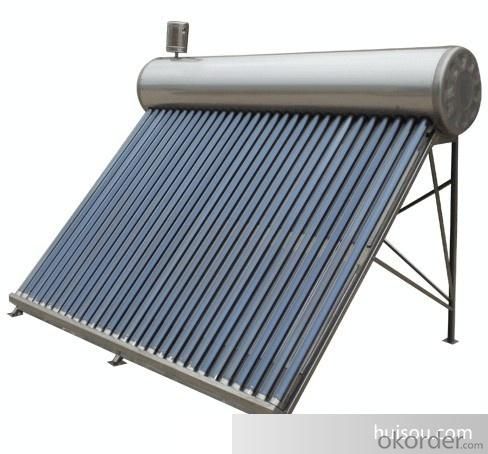
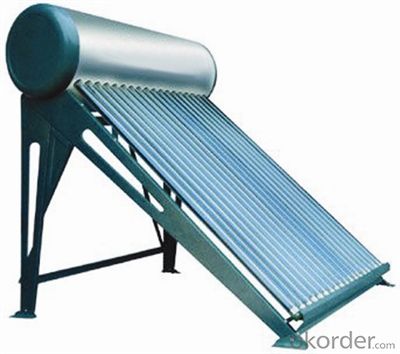
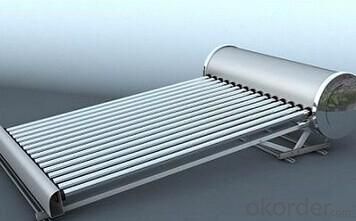
Our Services
1. OEM service
2. Warranty: 5 years
3. Considerable after sale service
Color steel Compact pressure Thermal solar heater
FAQ:
1. What’s the delivery time?
10 days after receiving deposit.
2. How long is the warranty?
5 years for whole system, 1 year for accessory
3. What’s your production capacity?
6000sets/month
4. What’s the MOQ?
1 set.
5. What’s your payment term?
Container: 30% T/T in advance for deposit, 70% T/T before shipment for fist order.
70% T/T after seeing copy of B/L from second order
Sample: 100% T/T in advance
Other choices: L/C at sight.
6. What certifications do you have?
CE, SOLAR KEYMARK, SRCC and etc.
- Q:Can solar collectors be used in disaster relief efforts?
- Yes, solar collectors can be used in disaster relief efforts. They provide a sustainable and reliable source of energy, enabling the operation of essential equipment, lighting, and communication devices in areas affected by disasters. Solar collectors also provide a clean and renewable energy solution, reducing the reliance on fossil fuels and minimizing environmental impact during relief operations.
- Q:Can solar collectors be used for heating museums and cultural centers?
- Yes, solar collectors can be used for heating museums and cultural centers. Solar thermal systems can capture the sun's energy and convert it into heat, which can then be used for space heating or water heating purposes in these buildings. This renewable energy source can provide a sustainable and cost-effective solution for heating while reducing greenhouse gas emissions. Additionally, solar collectors can be integrated into the architecture of these buildings without compromising their aesthetic value.
- Q:Are solar collectors suitable for agricultural greenhouses?
- Yes, solar collectors are suitable for agricultural greenhouses. They can effectively harness solar energy to provide heating, ventilation, and electricity, which are essential for maintaining optimal growing conditions in agricultural greenhouses. Solar collectors can help reduce energy costs and dependency on fossil fuels, making them an environmentally friendly and sustainable solution for greenhouse farming.
- Q:How much do solar collectors cost?
- The cost of solar collectors can vary depending on various factors such as the size of the system, the type of collectors used, and the specific requirements of the installation. On average, the cost of a solar collector system can range from $5,000 to $20,000. This includes the cost of the collectors, installation, and any necessary additional components such as storage tanks or pumps. It's important to note that while there is an upfront cost, solar collectors can provide significant long-term savings on energy bills and may also be eligible for government incentives or tax credits, further reducing the overall cost of the system. Additionally, the cost of solar collectors has been decreasing over the years due to advancements in technology and increased market competition, making them a more affordable and accessible option for homeowners and businesses.
- Q:How do solar collectors perform in polluted areas?
- Solar collectors may be affected by pollution in several ways. Firstly, air pollution can reduce the amount of sunlight reaching the collectors, thus decreasing their efficiency. The presence of dust and particles in the air can also settle on the surface of the collectors, reducing their ability to absorb sunlight. Additionally, pollution can lead to the formation of smog, which can further hinder the performance of solar collectors. Therefore, in polluted areas, solar collectors may not perform as efficiently as in cleaner environments. Regular cleaning and maintenance of the collectors can help mitigate some of the negative effects of pollution.
- Q:Can solar collectors be used in parking lots?
- Yes, solar collectors can be used in parking lots. Installing solar collectors in parking lots can help generate clean and renewable energy by harnessing sunlight and converting it into electricity. This energy can be used to power lighting systems, electric vehicle charging stations, or even feed back into the grid. Additionally, solar collectors in parking lots can provide shaded areas for vehicles, reducing heat buildup and improving overall comfort for users.
- Q:Can solar collectors be used in cloudy weather?
- Yes, solar collectors can still be used in cloudy weather. While the efficiency may be reduced, they can still generate electricity or heat by capturing diffuse sunlight.
- Q:Can solar collectors be used for heating agricultural processing facilities?
- Yes, solar collectors can be used for heating agricultural processing facilities. Solar thermal systems can effectively capture and convert sunlight into heat energy, which can then be used for various heating applications in agricultural processing facilities such as drying crops, heating water, or providing space heating. This renewable and sustainable solution can help reduce reliance on fossil fuels and lower operating costs for farmers and processors.
- Q:Can solar collectors be used for heating saunas?
- Yes, solar collectors can be used for heating saunas. Solar thermal collectors, also known as solar water heaters, can be connected to the sauna's heating system to provide heat. These collectors use the sun's energy to heat water, which is then circulated through the sauna's heating system to warm up the sauna. This is an eco-friendly and cost-effective way to heat saunas, as it utilizes renewable energy sources.
- Q:How do solar collectors affect carbon emissions?
- Harnessing the power of the sun, solar collectors offer a sustainable and eco-friendly method for generating electricity or heat. With their utilization, carbon emissions can be dramatically reduced. When traditional sources like coal, oil, and natural gas are burned for energy production, they release substantial amounts of carbon dioxide and other greenhouse gases. These emissions contribute to climate change and air pollution, resulting in various environmental and health issues. In contrast, solar collectors make use of sunlight to generate electricity or heat without emitting any greenhouse gases directly. By converting the sun's energy into usable power, they eliminate the need for fossil fuels and reduce our dependence on carbon-intensive energy sources. This not only helps mitigate carbon emissions but also fights against climate change. Furthermore, the environmental impact of solar collectors is minimal throughout their lifespan. Compared to conventional energy systems, the production, operation, and maintenance of solar collectors generate extremely low levels of greenhouse gas emissions. Additionally, solar energy is a renewable resource that will never be depleted, unlike fossil fuels. By implementing solar collectors on a large scale, the generation of electricity and heat can significantly reduce carbon emissions. This transition to clean and sustainable energy sources is crucial for achieving global climate goals and creating a more sustainable future for our planet.
1. Manufacturer Overview |
|
|---|---|
| Location | |
| Year Established | |
| Annual Output Value | |
| Main Markets | |
| Company Certifications | |
2. Manufacturer Certificates |
|
|---|---|
| a) Certification Name | |
| Range | |
| Reference | |
| Validity Period | |
3. Manufacturer Capability |
|
|---|---|
| a)Trade Capacity | |
| Nearest Port | |
| Export Percentage | |
| No.of Employees in Trade Department | |
| Language Spoken: | |
| b)Factory Information | |
| Factory Size: | |
| No. of Production Lines | |
| Contract Manufacturing | |
| Product Price Range | |
Send your message to us
Pressurized Heat Pipe Solar Water Heater System
- Loading Port:
- China main port
- Payment Terms:
- TT OR LC
- Min Order Qty:
- 1 set
- Supply Capability:
- 6000 set/month
OKorder Service Pledge
OKorder Financial Service
Similar products
New products
Hot products
Hot Searches
Related keywords













